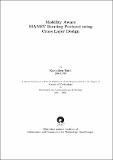Please use this identifier to cite or link to this item:
http://drsr.daiict.ac.in//handle/123456789/113Full metadata record
| DC Field | Value | Language |
|---|---|---|
| dc.contributor.advisor | Srivastava, Sanjay | |
| dc.contributor.advisor | Lenin, R. B. | |
| dc.contributor.author | Patel, Komalben | |
| dc.date.accessioned | 2017-06-10T14:37:01Z | - |
| dc.date.available | 2017-06-10T14:37:01Z | - |
| dc.date.issued | 2006 | |
| dc.identifier.citation | Patel, Komalben (2006). Mobility aware MANET routing protocol using cross layer design. Dhirubhai Ambani Institute of Information and Communication Technology, vii, 52 p. (Acc.No: T00076) | |
| dc.identifier.uri | http://drsr.daiict.ac.in/handle/123456789/113 | - |
| dc.description.abstract | Mobile Adhoc Network (MANET) is a dynamic network with time varying topology and time varying network resources. Due to the error-prone wireless channel and high mobility, traditional protocols of wired networks cannot be successfully applied to MANETs. The popularity of mobile and hand held devices equipped with wireless interface is creating a new challenge for Quality of Service. The wired network has also not been able to fulfill end-to-end guarantees. Due to the nature of MANETs, achieving the same end-to-end guarantees is very difficult. The mobility rate makes the task dicult. The aim is to fight against the losses caused due to mobility. This work attempts to build stable paths so as to counter the effects of mobility induced route failures. Using the Cross Layer Approach, the signal strength of the link from the MAC Layer is captured and used at the network layer. Upon receiving the signal strength values, the network layer carries out a prediction mechanism to predict the future signal strength. This information is then used to categorize the link as stable or unstable. The work also deals with designing a proactive routing protocol which uses the information of stable and unstable links to build up routes using limited dissemination technique. The protocol is similar to distance vector protocol in which, only the distance vectors whose next hop is a stable is advertised. This ensures that only stable link information reaches the other nodes in the network. The protocol has been tested in Network Simulator-2 and compared with the Destination Sequenced Distance Vector [PB94] and the Adhoc On-Demand Distance Vector [PR97] protocols. Various parameters like percentage of packet delivery, packet latency, effects of moblity, etc. are measured. The results show that the performance of the designed protocol is better than AODV in high traffic scenarios. With less overhead, the proposed protocol always performs better than DSDV. In high mobility scenarios, the protocol is comparable to AODV and performs better than DSDV. | |
| dc.publisher | Dhirubhai Ambani Institute of Information and Communication Technology | |
| dc.subject | Ad-hoc wireless networks | |
| dc.subject | Mobile ad-hoc networks | |
| dc.subject | Routing protocol | |
| dc.subject | Routers | |
| dc.subject | Wireless communication systems | |
| dc.classification.ddc | 004.65 PAT | |
| dc.title | Mobility aware MANET routing protocol using cross layer design | |
| dc.type | Dissertation | |
| dc.degree | M. Tech | |
| dc.student.id | 200411013 | |
| dc.accession.number | T00076 | |
| Appears in Collections: | M Tech Dissertations | |
Files in This Item:
| File | Description | Size | Format | |
|---|---|---|---|---|
| 200411013.pdf Restricted Access | 1.37 MB | Adobe PDF |  View/Open Request a copy |
Items in DSpace are protected by copyright, with all rights reserved, unless otherwise indicated.
